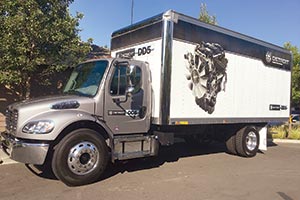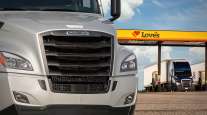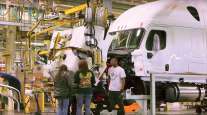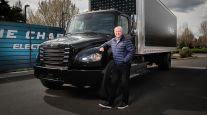DTNA to Start Medium-Duty Engine Production

This story appears in the Aug. 8 print edition of Transport Topics.
YOUNTVILLE, Calif. — Daimler Trucks North America announced its Detroit-branded DD5 medium-duty engine will officially hit the market later this year in the Freightliner M2 106 model.
Production on the 4-cylinder engine is scheduled to begin in October, with deliveries planned for the end of the year, company executives said here July 28.
“Our entry into the medium-duty engine market is a significant step,” said Richard Howard, DTNA senior vice president of sales and marketing.
“We feel we’re well-prepared to bring this engine to the market,” said Kary Schaefer, general manager of marketing and strategy. She said the company is offering a three-year, 250,000-mile warranty covering both the engine and its aftertreatment system.
DTNA first announced its plans for the engine in October 2014 at American Trucking Associations’ Management Conference & Exhibition. Until now, Detroit Diesel’s engines had been heavy-duty offerings. Moving forward, DTNA will continue to provide customers the option of a Cummins Inc. engine, much as it offers choices for heavy-duty engines, transmissions and axles.
“We want to sell trucks with either engine,” Howard said, adding that the “big change is there is now a choice.”
The 5.1-liter engine initially will be marketed toward the pickup- and-delivery segment and feature ratings of 210 horsepower and 575 pound-feet of torque, as well as 230 hp and 660 pound-feet.
“There is no less performance from the 4-cylinder than the 6-cylinder,” said Schaefer, who noted a 3% fuel economy gain over competitive engines.
Detroit also is providing customers the Detroit Connect Virtual Technician remote diagnostics system. Additional ratings for a wider range of vocational applications are expected to come later, and the company still plans to roll out the larger DD8 engine in 2018.
The initial Class 6 trucks test-driven by journalists here included a 20-foot dry van body, Detroit axles and the Allison 2500 RDS transmission.
The engine, which uses many designs found on the heavy-duty platform, will first be produced in Germany, but plans remain on track to shift production to the plant in Redford, Michigan, company executives confirmed. That follows the production path of the Detroit DT12 automated manual transmission.
Management said the DD5, which meets the federal Jan. 1, 2017, greenhouse-gas and fuel- efficiency standards, offers extended maintenance intervals, including oil and fuel filter-change intervals up to 45,000 miles.
Analyst Michael Baudendistel of Stifel, Nicolaus & Co. said last week, “There is potential for market share loss [for Cummins] in medium-duty especially, due to the introduction of the new DD5 and DD8 engines at Daimler and new in-house powertrain initiatives at Ford.”
During 2015, Freightliner was the market leader in Class 7, selling 26,251 trucks, a market share of 44.6%, according to WardsAuto.com. For the first half of 2016, Freightliner sold 14,318 Class 7 trucks for a 50.4% share.
Freightliner also led in Class 6 last year, selling 19,842 trucks for a 36% market share. However, through June 2016, it was No. 2 behind Ford Motor Co. with sales of 9,715 trucks.
Separately, DTNA parent Daimler AG said its Mercedes-Benz division plans to start selling an electric heavy-duty truck in about five years. The Urban eTruck will have a range of about 120 miles per battery charge. It is targeted for inner-city tasks such as supermarket deliveries and could go on sale by “the start of the next decade,” Daimler said.
“Until now, no one’s been making money from electric vehicles,” Wolfgang Bernhard, head of the Daimler global trucks division, said at a presentation at headquarters in Stuttgart, Germany. “But those who are too late with new technology lose market share, and that’s why these models are coming out now.”
Daimler’s announcement came a week after Tesla CEO Elon Musk said a freight truck is set for introduction next year.
Technology advances are likely to cut the cost of batteries by 60% while power output triples by 2025 from 1997 levels, according to Daimler. About 10% of trucks make deliveries in urban areas, making them the prime models to be electrified, Bernhard said.
Developments in technology “will soon make electric trucks economical, but this will have limited applications,” he said. “For long-distance freight, the progress with batteries hasn’t gone far enough.”
Sales of electric models might account for 4% of European Union and U.S. medium- and heavy-duty truck sales by 2025, according to research company IHS Markit.
Associate News Editor Jonathan S. Reiskin and Bloomberg News contributed to this story.




